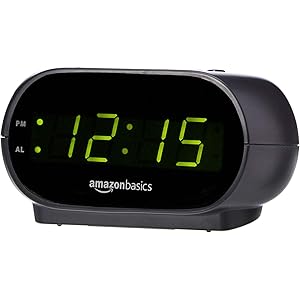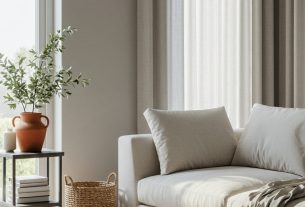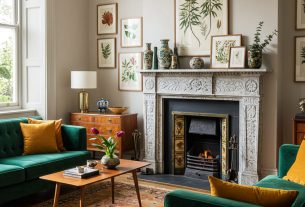As an avid enthusiast of interior design, I often find myself captivated by the nuances that make this field endlessly fascinating. It’s not just about arranging furniture or selecting paint colors; it’s about creating spaces that evoke emotions, tell stories, and enhance our daily lives. In this article, I’ll explore what makes interior design interesting, uncover current trends, and share my thoughts on how this field continues to evolve. So, let’s embark on this journey together!
The Emotional Connection in Interior Design
One of the most compelling aspects of interior design is its ability to forge emotional connections. Every element in a space can evoke feelings, whether it’s nostalgia, comfort, or inspiration. I remember walking into a friend’s home decorated with vintage pieces from their childhood. The warmth and familiarity of those items created a sense of belonging that made the space inviting.
To illustrate this, consider the psychological impact of color. Studies have shown that different colors can evoke specific emotions:
- Blue: Calming and serene, often associated with tranquility.
- Red: Energizing and passionate, it can stimulate conversation.
- Yellow: Cheerful and uplifting, it brings a sense of happiness.
- Green: Refreshing and natural, it promotes balance and harmony.
Understanding these color associations is crucial for designers aiming to create spaces that resonate with their occupants. The ability to manipulate these elements to foster emotional connections is what makes interior design truly fascinating.
Trends Shaping the Future of Interior Design
As I delve deeper into the realm of interior design, I can’t help but notice the trends that continually reshape our environments. Here are some of the most exciting trends currently influencing the industry:
Sustainable Design
Sustainability has transcended being a mere buzzword to become a fundamental principle in interior design. I’ve seen a remarkable shift toward eco-friendly materials and practices. Designers are increasingly utilizing:
- Recycled materials
- Bamboo and cork flooring
- Low-VOC paints
- Energy-efficient lighting
According to a report from Statista, the global green building market is projected to reach a staggering $689 billion by 2027. This growth reflects a collective awareness of our environmental impact and the desire to create healthier living spaces.
Biophilic Design
Another trend that has captured my attention is biophilic design, which emphasizes the connection between humans and nature. By incorporating natural elements, such as plants and water features, designers can create environments that promote well-being. I’ve personally experienced the benefits of biophilic design; a simple indoor garden in my home has transformed my space into a tranquil oasis.
Research from Frontiers in Psychology suggests that exposure to nature can reduce stress, improve mood, and enhance cognitive function. This evidence validates the importance of integrating natural elements into our interiors.
Smart Home Technology
The rise of smart home technology has revolutionized how we interact with our living spaces. From smart thermostats to integrated lighting systems, technology enhances convenience and efficiency. I find it fascinating how these innovations are becoming increasingly user-friendly, allowing anyone to transform their home into a smart environment.
According to a Statista survey, nearly 70% of U.S. households have at least one smart home device. This trend signifies a shift in how we perceive our living spaces, merging functionality with design.
Minimalism and Maximalism
Interior design is also witnessing a tug-of-war between minimalism and maximalism. On one hand, minimalism emphasizes simplicity, clean lines, and functional spaces. I’ve always admired the serene beauty of minimalistic designs, where every item serves a purpose and contributes to a cohesive aesthetic.
Conversely, maximalism celebrates boldness, color, and individuality. It encourages mixing patterns and textures, allowing for a more expressive approach to design. I’ve seen some incredible maximalist interiors that reflect the personality of the occupants, creating spaces that are as unique as their inhabitants.
The Role of Personalization in Interior Design
In a world that often feels homogenized, personalization has become a vital component of interior design. I believe that our homes should be a reflection of who we are, showcasing our stories and experiences. Here are a few ways to infuse personalization into design:
- Artwork: Incorporating personal art pieces or photographs adds a unique touch.
- Family Heirlooms: Displaying cherished items can evoke memories and create a sense of history.
- Color Choices: Selecting colors that resonate personally can transform a space.
- Custom Furniture: Investing in bespoke pieces ensures that your furniture is one-of-a-kind.
By embracing personalization, we can create spaces that not only meet our functional needs but also nurture our identities.
The Importance of Functionality
While aesthetics play a significant role in interior design, functionality is equally crucial. A beautiful space that lacks practical use can quickly become frustrating. I’ve learned that the best designs balance form and function, creating environments that are both visually appealing and livable.
For instance, open floor plans have gained popularity for their versatility, allowing for fluid movement between spaces. However, I’ve also encountered challenges with noise and privacy in such layouts. The key is to design with intention, considering the specific needs and lifestyles of the occupants.
Case Studies: Successful Interior Design Projects
To further illustrate the principles discussed, let’s examine a few successful interior design projects that embody these trends and concepts:
The High Line Hotel, New York City
The High Line Hotel, a former seminary turned boutique hotel, is a stunning example of successful interior design. The space retains its historical charm while incorporating modern elements. The designers embraced:
- Restoration of original architectural features
- Thoughtful use of color and texture
- Incorporation of local artwork
- Functional communal areas
This project exemplifies how blending history with contemporary design can create a captivating experience for guests.
Kip’s Bay Decorator Show House
The annual Kip’s Bay Decorator Show House showcases the work of leading interior designers, each presenting their unique vision. I find this event particularly inspiring, as it highlights innovation and creativity in design. The 2021 show house featured:
- Bold color palettes
- Eclectic furniture choices
- Incorporation of sustainable materials
- Personalized spaces
This showcase serves as a reminder that interior design is not just about trends but also about expressing individuality and creativity.
Statistics That Matter in Interior Design
To provide a clearer picture of the interior design landscape, here are some compelling statistics:
- The global interior design market is expected to reach $255 billion by 2025, according to Statista.
- Approximately 50% of homeowners reported that they plan to invest in home improvement projects in the next year, based on a survey by HomeAdvisor.
- In a study by the Houzz, 90% of homeowners stated that they prioritize functionality in their kitchen designs.
These statistics highlight the growing interest in interior design and the importance of creating spaces that are both beautiful and practical.
Conclusion: The Ever-Evolving World of Interior Design
As I reflect on what makes interior design interesting, I realize that it’s a dynamic field that continually evolves, shaped by cultural shifts, technological advancements, and personal preferences. From the emotional connections we forge with our spaces to the trends that redefine our environments, interior design is a rich tapestry of creativity and functionality.
Whether you’re a professional designer or someone looking to refresh your home, understanding these principles can lead to spaces that are not only visually stunning but also deeply meaningful. I encourage you to explore these trends, personalize your spaces, and embrace the transformative power of design.
FAQ
What are the current trends in interior design?
Current trends include sustainable design, biophilic design, smart home technology, and a blend of minimalism and maximalism.
How can I personalize my interior space?
You can personalize your space by incorporating artwork, family heirlooms, choosing colors that resonate with you, and investing in custom furniture.
Why is functionality important in interior design?
Functionality ensures that a space is livable and meets the needs of its occupants, balancing aesthetics with practical use.
If you enjoyed this article and want to stay updated on the latest trends in interior design, I invite you to sign up for our newsletter! Don’t forget to share this article with your friends and on social media. Let’s spread the passion for beautiful design together!
Amazon Basics Small Digital Oval Alarm Clock With LED Display, Nightlight & Battery Backup, Black, 4.5 x 3.5 x 2.4 Inches
$8.99 (as of 14/11/2025 03:50 GMT -03:00 - More infoProduct prices and availability are accurate as of the date/time indicated and are subject to change. Any price and availability information displayed on [relevant Amazon Site(s), as applicable] at the time of purchase will apply to the purchase of this product.)
Sign up for our newsletter and stay up to date with exclusive news
that can transform your routine!




